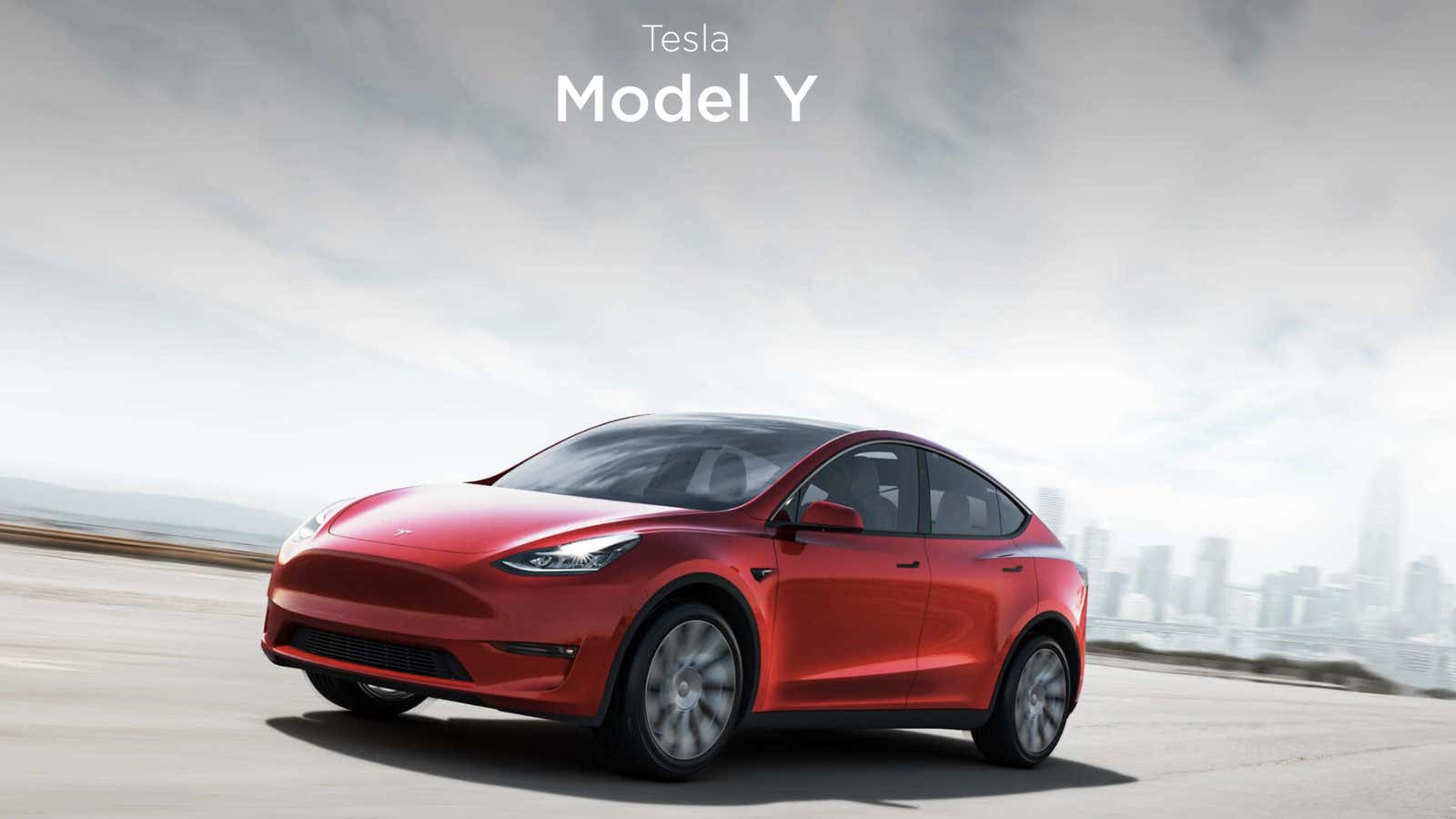Elon Musk strode on stage in Los Angeles this evening (March 14) to introduce the final addition to Tesla’s “sexy” lineup: the Model Y. It is Tesla’s first compact SUV (and the electric carmaker’s fifth model). The SUV Tesla rolled out puts the electric carmaker in one of the world’s hottest car segments—and up against incumbents ready to defend their turf after watching the Model S and Model 3 erode their share of premium sedans last year.
The invite-only crowd seemed slightly more subdued than at previous car launches, but cheered Musk as he ran through the Model Y’s features. The SUV is expected to have a 230-mile range (extendable up to 300 miles), a 0-60 mph acceleration time of 3.5 seconds, and an option for seven seats. Like the Model 3 (with which it shares 75% of its parts and a chassis), the SUV comes with a panoramic glass roof and Autopilot features. Tesla aims to start selling a $60,000 performance version next fall, followed by a $39,000 model in 2021. You can pre-order the Model Y.
The car arrives at a critical time for Tesla. It’s blockbuster Model 3 is taking over the (shrinking) sedan market. With some 140,000 units sold in 2018, the Model 3 was the best-selling electric car in the US last year (and sold more than four times that of the second-ranking Toyota Prius Prime) and the fifth best-selling sedan overall. The Model 3 accounted for 20% of the 700,000 mid-priced sedans (categorized as those costing $30,000 to $50,000) sold in the US in 2018.
But for the electric carmaker to survive, it needs to be a major player in the world’s most popular and growing segment: SUVs. Many other countries are now developing a taste for the bigger vehicles that have been a mainstay of North American garages for years such as the top-selling Ford Explorer and smaller “crossovers,” or SUVs built on a car chassis.
The SUV’s share of the global auto market has risen from 22% to more than a third since 2014, reports automotive intelligence firm JATO Dynamics. Most of that growth has come in countries like China (sales growth of 13% in 2017 compared with 2016), Japan (30%), Middle East (19%), and South America (40%).
That’s not good news for the planet. While SUVs are becoming more fuel efficient, they have dramatically slowed progress on emissions reductions. The average fuel economy for the world’s new autos must fall by 3% per year to meet climate targets, reports The New York Times, and that’s not happening. On stage, Musk said he wanted the Model Y to be the next step toward a more sustainable future by reducing greenhouse gas emissions, and his intention was to pressure the entire industry to follow Tesla’s lead into EVs. “It’s extremely rewarding to see the rest of the industry going electric,” he said.
Musk predicted the Model Y would sell more units than the Model 3 and Model S, combined. Michael Harley, executive editor at Kelley Blue Book called the Model Y Tesla’s biggest opportunity so far. “It’s price and body style should resonate with the majority of today’s car buyers,” he said in a statement.
But Tesla’s EV market is getting crowded. The $70,000 Jaguar iPace SUV boasts comparable specs. Porsche’s all-electric Cross Turismo SUV due to start production in 2020 has drawn positive reviews. Audi has plans to launch its $74,800 e-tron SUV by the time the Model Y arrives next year.
Tesla has fought off challengers before. Now it will have more rivals in the fight.
Looking for more in-depth coverage of electric cars? Sign up for a free trial of Quartz membership, and read our premium field guide on China’s electric-vehicle boom.




